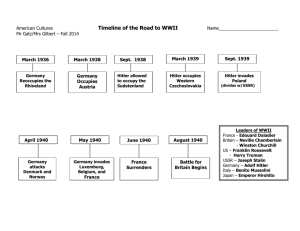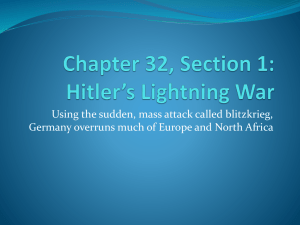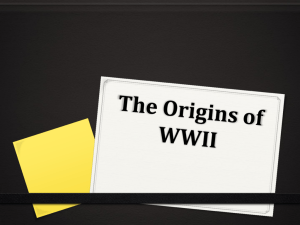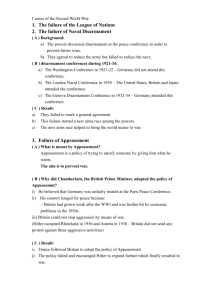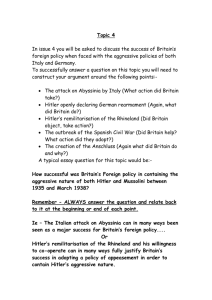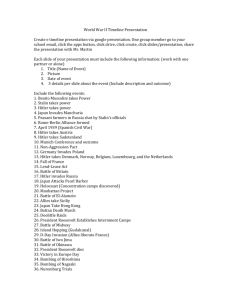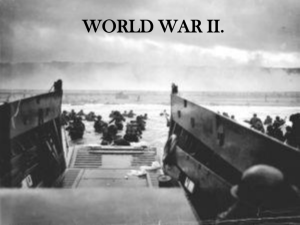American Foreign Policy Between The Wars
advertisement
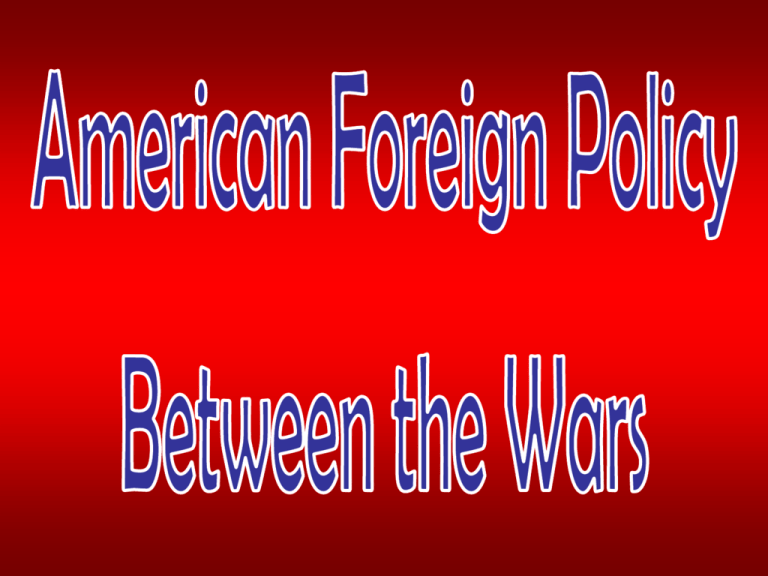
Desire for Isolationism • After WWI, Americans wanted to return to “Normal” – Let Europe deal with Europe • Refused to support Wilson & the League of Nations Sen. Henry Cabot Lodge A Weak League of Nations • Strength undercut when the U.S. refused to join – No control of major conflicts – No progress in disarmament – No effective military force Washington Disarmament Conference • U.S., Britain, & Japan had all continued building up their navies • Goal: naval disarmament • All major naval powers invited • Met in Washington from 1921-1922 Five Power Treaty (1922) • A battleship ratio was achieved: US 5 Britain 5 Japan 3 France 1.67 Italy 1.67 • U.S. and Britain would stop fortifying their Far East territories (including the Philippines) • Loophole: no restrictions on smaller ships Kellogg-Briand Pact (1928) • 15 nations agreed to outlaw aggression and war as tools of foreign policy • 62 nations eventually signed • Problems no means of actual enforcement • Gave Americans a false sense of security during the 1930’s The Great Depression • World wide effects • Countries look for solutions • Some turn toward FASCISM – glorified the state and sought to expand – Italy (Mussolini), Japan, & Germany (Hitler) all turn to Fascism Japan Invades Manchuria (1931) • Japanese military assumed control of the government • Invaded Manchuria for resources • League of Nations condemned the action • Japan leaves the League Japan Invades Manchuria (1931) Stimson Doctrine • Issued in 1932 • US would not recognize any territorial acquisitions that were achieved by force • Japan was infuriated, but there was no real U.S. threat Sec of State Harry Stimson The Good Neighbor Policy • Groundwork created by Hoover – Removed U.S. troops from Latin America • FDR fully develops program – a policy of nonintervention and cooperation The good neighbor respects himself and the rights of others. • Renounces the Roosevelt Corollary Nye Committee Hearings (1934-36) • Munitions manufacturers blamed as “Merchants of Death” for WWI • Senate investigative hearings begin • Committee blames banks & munitions manufactures for the war • Led to passage of several Neutrality Acts Senator Gerald P. Nye Neutrality Acts (1935, 1936, & 1937) • Passed to keep the U.S. out of new wars • When the president proclaimed a foreign war Americans couldn’t : – sail on belligerent nations’ ships – Sell or transport munitions to belligerents – Make loans to a belligerent • The U.S. refused to build up the armed forces Growing Fascist Aggression • 1935: • 1936: Italy invades Ethiopia Hitler begins to re-arm Germany Hitler re-militarizes the Rhineland • 1937: Japan invades China Rape of Nanking Panay Incident (1937) • American ship Panay bombed and sunk by Japanese • Japan apologized, paid US an indemnity, and promised no further attacks • Results Japanese interpreted US tone as a license for further aggression against US interests • 1938: German Anschluss with Austria Rome-Berlin Axis Formed Germany demands the Sudetenland Munich Agreement • Sept 1938 meeting between Hitler, Italy, Britain, & France • Britain & France appease Hitler by giving him the Sudetenland Now we have “peace in our time!” Herr Hitler is a man we can do business with. • 1939: Hitler invades the rest of Czechoslovakia Nazi-Soviet Non-Aggression Pact signed The Invasion of Poland • September 1, 1939 Hitler invades Poland using new strategy of Blitzkrieg • September 3 France & Britain declare war on Germany Neutrality Act of 1939 • FDR persuades Congress to aid European democracies in a limited way: – The US could sell weapons to the European democracies on a “cash-and-carry” basis – Proclaimed danger zones which US ships and citizens could not enter Beginnings of War • Phony War – 1st 7 months of fighting • June 1940: Hitler invades France France Surrenders • June 22, 1940 • Divided into 2 Battle of Britain • Operation Sea Lion • July 1940 – May 1941 • Hitler tries to invade Great Britain • Known as “The Blitz” • German Luftwaffe bombs Britain to soften resistance Now Britain Is All Alone! The London “Tube”: Air Raid Shelters during the Blitz Tripartite Pact (Sept 1940) • Also known as the Rome-BerlinTokyo Axis Destroyers for Bases (1940) • Sept 1940, Britain close to surrender • Needs ships to fight Battle of Atlantic against UBoats • U.S. trades 50 WWI destroyers for land bases America First Committee • Formed in September 1940 • Purpose was to pressure the government to stay OUT of war Lend-Lease Act (1941) • The U.S. will lend supplies to Allies in return for leases on land after the war • America becomes the “Arsenal of Democracy” Great Britain.........................$31 billion Soviet Union...........................$11 billion France......................................$ 3 billion China.......................................$1.5 billion Other European.................$500 million South America...................$400 million The amount totaled: $48,601,365,000 What do I do in such a crisis? I don't say... 'Neighbor, my garden hose cost me $15; you have to pay me $15 for it' …I don't want $15 — I want my garden hose back after the fire is over." Operation Barbarossa • Hitler invades the Soviet Union in June 1941 • Soviet Union becomes an unlikely Allied Power The Atlantic Charter • Roosevelt and Churchill sign treaty outlining war goals • Solidifies alliance • Fashioned after Wilson’s 14 Points • Called for collective security, disarmament, selfdetermination, economic cooperation, freedom of the seas, & a new peace-keeping organization
